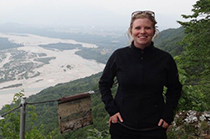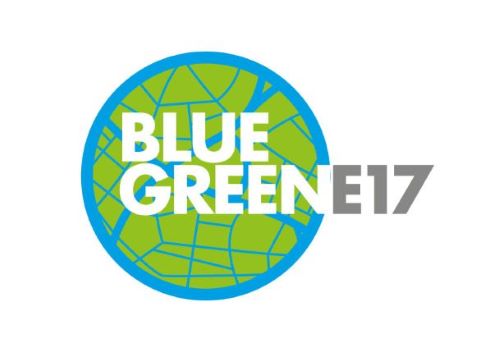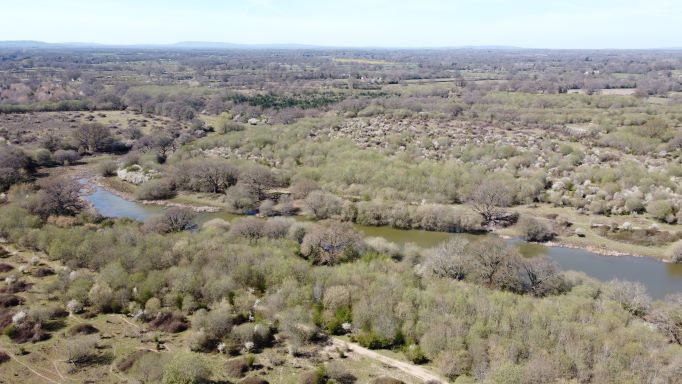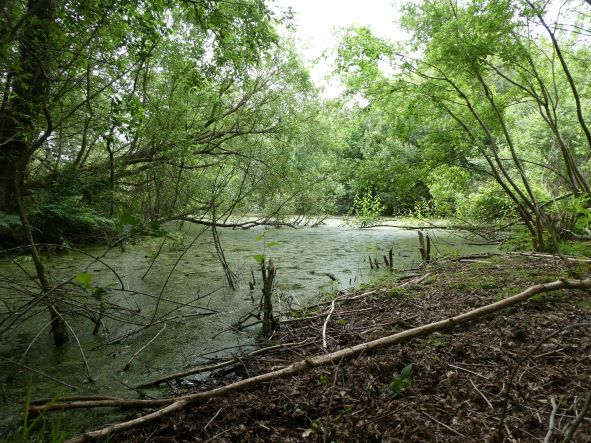Professor Gemma Harvey

Professor of Physical Geography
Email: g.l.harvey@qmul.ac.uk
Telephone: +44 (0)20 7882 2722
Room Number: Geography Building, Room 212
Profile
My research focuses on biogeomorphology and landscape restoration and rewilding. This includes theoretical and empirical contributions to understanding the feedbacks between plants and animals and Earth surface processes, and how these influence landscape restoration and management. This informs best practice in river restoration and flood risk management, invasive species management and, most recently, nature recovery approaches and carbon credit protocols. My research is strongly interdisciplinary and involves close collaboration with ecologists, environmental engineers, soil scientists, economic and cultural geographers and artists.
I work with local and national stakeholders in the environmental sector, including pioneering rewilding sites, government agencies, NGOs, local action groups and green tech companies on landscape rewilding and urban greening projects funded by NERC/ ESRC, Defra/ Environment Agency and Research England. I am a member of the QMUL East London Research Network and QMUL Impact Forum.
I have been Associate Editor for the ‘Water and Life’ domain of influential Wiley journal WIREs Water (Impact Factor: 8.2) since 2014.
I currently hold a NERC Knowledge Exchange Fellowship on Embedding environmental and geospatial science in nature recovery and rewilding (2024-26). I previously held a Leverhulme Research Fellowship (Natures engineers: uncovering signatures of life in landscapes, 2022-23) funding my research on the role of animals in landform and landscape evolution.
Key publications:
- Harvey GL and Henshaw AJ (2023) Rewilding and the water cycle. WIREs Water. doi: 10.1002/wat2.1686
- Cashman MJ, Harvey GL and Wharton G (2021) Structural complexity influences the ecosystem engineering effects of in‐stream large wood. Earth Surface Processes and Landforms, 46(10): 2079-2091.
- Harvey GL, Henshaw AJ, Brasington J and England J (2019) Burrowing invasive species: an unquantified erosion risk at the aquatic-terrestrial interface. Reviews of Geophysics. DOI:10.1029/2018RG000635.
- Harvey GL, Henshaw AJ, Parker C, Sayer CD. (2018) Re-introduction of structurally complex wood jams promotes channel and habitat recovery from overwidening: Implications for river conservation. Aquatic Conservation: Marine and Freshwater Ecosystems: 28: 395-407.
- Tempest JA, Harvey GL and Spencer KL (2015) Modified sediments and subsurface hydrology in natural and recreated saltmarshes and implications for delivery of ecosystem services. Hydrological Processes 29: 2346–2357 DOI: 10.1002/hyp.10368.
- Harvey, G. L., Henshaw, A.J., Moorhouse, T.P., Clifford, N. J., Holah, H., Grey, J. and Macdonald, D. W. (2014) Invasive crayfish as drivers of fine sediment dynamics in rivers: field and laboratory evidence. Earth Surface Processes and Landforms 39: 259-271.
Teaching
I teach at undergraduate and postgraduate level, across a research-led pathway in biogeomorphology, environmental restoration and nature recovery. I have led the Water and Environmental Management MSc since 2012, supporting students into diverse careers with leading environmental organisations including Arcadis, Defra, Jacobs, South East Rivers Trust and WSP.
In addition to lectures and seminars, my teaching incorporates physical modelling experiments in our River Lab, statistical analysis of research data sets, field teaching at my research sites and virtual field trip experiences.
I develop modules and research projects that engage our students with external organisations and events related to environmental management to support future careers in the water and environment sector.
Modules taught:
- GEG4013 Planetary emergencies: from analysis to action (lecturer)
- GEG5225 Geomorphology (convenor)
- GEG7317 River Assessment and Restoration (lecturer)
- GEG7314 Flood Risk Management and Modelling (lecturer)
- GEG7308 Individual Research Project (convenor)
Research
Research Interests:
Current projects are aligned with the following themes:
(i) Nature recovery and ecosystem services
Landscape rewilding is the practice of returning modified landscapes to a wilder state to help reverse biodiversity decline, and may include the reintroduction of missing animal species. The fundamental principles that underpin rewilding offer potential for wide-ranging benefits to support freshwater and terrestrial natural capital assets and ecosystem services but understanding of these wider effects is limited. My research in this area is exploring the impact of rewilding on hydrological extremes (NERC/ ESRC project Biodiversity and the water cycle; Bull and Hartley PhDs) and contributing to the development of a scalable protocol for carbon credits for rewilding and nature recovery projects (funded by Defra/ Environment Agency Natural Investment Readiness Fund). Using QMUL HSS funding we have created novel data sets characterising vegetation regeneration over 20 years at pioneering rewilding site Knepp Wildland, and these are now supporting diverse research projects.
(ii) Natures engineers: uncovering signatures of life in landscapes
Understanding when and how life leaves a geomorphological signature within landscapes is a major research challenge for the field of biogeomorphology, which explores the interactions between living organisms and Earth surface processes and landforms. The role of animals as ‘zoogeomorphic agents’ in the evolution of landforms and landscapes is greater than is widely recognised, and has major implications for environmental resilience, restoration and hazards. I currently hold a Leverhulme Research Fellowship (2022-23) during which I will establish a novel global data set that captures animal impacts on geomorphological forms and processes across terrestrial and aquatic environments. I will then use this new resource to uncover the diversity and global distribution of zoogeomorphic agents and the characteristics and significance of their signatures. This new understanding will help answer the fundamental question ‘is there a geomorphological signature of life?’.

(iii) Wilder, greener urban futures
My current research in this area is facilitating the translation and adaptation of rewilding principles, ideas and approaches to urban environments for the benefit of people and nature. A Research England participatory research grant and a QMUL Centre for Public Engagement Large Grant support our work on BlueGreenE17, a project involving the co-creation of a vision for a wilder future for Walthamstow in east London. Working with residents and over 20 stakeholder organisations and groups we are exploring existing green and blue spaces in Walthamstow and different aspects of their connectivity. Combining interviews, photomapping surveys, geospatial analysis and a public exhibition, we are bringing together diverse perspectives on the barriers and opportunities for increasing, improving and connecting green spaces (vegetation) and blue spaces (water bodies) in cities.
Publications
A full list of publications is available here
- Harvey GL, Khan Z, Albertson LK, Coombes, M, Johnson MF, Rice SP, Viles HA (2025) Global diversity and energy of animals shaping the Earth's surface. Proceedings of the National Academy of Sciences 122 (8) doi: 10.1073/pnas.2415104122
- Pearce, RH, Sayer S, Chadwick M, Perrow M, Worthington T, Harvey G, Tosney J (2024) Bringing the Burbot back to English rivers. British Wildlife 36 (1): 17- 27.
- Johnson MF, Alberston LK, Everall NC, Harvey GL, Mason R, Pledger A, Rice SP and Thorne CR (2024) Accounting for the power or nature: using flume and field studies to compare the capacities of bio-energy and fluvial energy to move surficial gravels. Earth Surface Processes and Landforms doi: 10.1002/esp.5846
- Harvey GL, Hartley AT, Henshaw AJ, Khan Z, Clarke SJ, Sandom CJ, England J, King S and Venn O (2024) The role of rewilding in mitigating hydrological extremes: state of the evidence. WIREs Water doi: 10.1002/wat2.1710
- Chalmers A, Carroll A, Long S, de Klee I, Hay M, Trewick L, Biddell M, Grocott H, Black H, Leeson A, Henshaw A, Harvey G and Khan Z (2024) Knepp Wildland carbon project [Report]. Available at: https://www.arup.com/insights/knepp-wildland-carbon-project/
- Harvey GL (2023) Ecosystem engineers in water environments. WIREs Water Virtual Collection (curator). Available here.
- Harvey GL and Henshaw AJ (2023) Rewilding and the water cycle. WIREs Water. doi: 10.1002/wat2.1686
- Trinci G, Harvey GL, Henshaw AJ, Bertoldi W (2022) Turbulence signatures of natural river morphology in four dimensions. River Research and Applications. doi:10.1002/rra.4071
- Harvey GL, Henshaw AJ, Koch R, Monteith W, Stansfeld K (2022) BlueGreenE17: co-creating a vision for a wilder Walthamstow [website]. Available at: bit.ly/bluegreene17
- Henshaw AJ, Harvey GL, Walley Y, Green P and de Klee I (2021) A bird's-eye view of the Wildland: 20 years of vegetation regeneration at a pioneering rewilding project [website]. Available at: https://arcg.is/C5mDP.
- Henshaw AJ, Walley Y, Harvey GL, Green P, and de Klee I (2021) Knepp WildVeg Geodatabase [Data set]. Zenodo. https://doi.org/10.5281/zenodo.5556945.
- Cashman MJ, Harvey GL and Wharton G. (2021) Structural complexity influences the ecosystem engineering effects of instream large wood. Earth Surface Processes and Landforms 46:2079–2091.
- Trinci G, Harvey GL, Henshaw AJ, Bertoldi W and Hölker F (2020) Turbulence, instream wood and fish: Ecohydraulic interactions under field conditions. Ecohydrology p.e2211.
- Harvey GL, Henshaw AJ, Brasington J and England J (2019) Burrowing invasive species: an unquantified erosion risk at the aquatic-terrestrial interface. Reviews of Geophysics 57: 1018-1036.
- Pinto C, Ing R, Browning B, Delboni V, Wilson H, Martyn D and Harvey GL (2019) Hydromorphological, hydraulic and ecological effects of restored wood: findings and reflections from an academic partnership approach. Water and Environment Journal 33: 353-365.
- Cashman M, Wharton G, Harvey GL, Naura M and Bryden A (2018) Trends in the use of large wood in UK river restoration projects: insights from the National River Restoration Inventory. Water and Environment Journal 33: 318-328.
- Connor-Streich G, Henshaw AJ, Brasington J, Bertoldi W and Harvey GL (2018) Let’s get connected: a new graph theory-based approach and toolbox for understanding braided river morphodynamics. WIREs Water DOI: 10.1002/wat2.1296.
- Harvey GL, Henshaw AJ, Parker C, Sayer CD. (2018) Re-introduction of structurally complex wood jams promotes channel and habitat recovery from overwidening: Implications for river conservation. Aquatic Conservation: Marine and Freshwater Ecosystems: 28: 395-407.
- Trinci G, Harvey GL, Henshaw AJ, Bertoldi W and Hölker F (2017) Life in turbulent flows: interactions between hydrodynamics and aquatic organisms in rivers. WIREs Water 4: e1213. doi:10.1002/wat2.1213.
- Parker C, Henshaw AJ, Harvey GL, and Sayer CD (2017) Reintroduced large wood modifies fine sediment transport and storage in a lowland river channel. Earth Surface Processes and Landforms 42: 1693–1703. doi: 10.1002/esp.4123.
- Spencer KL, Carr SJ, Diggens LM, Tempest JA, Morris MA, Harvey GL (2017) The impact of pre-restoration land-use and disturbance on sediment structure, hydrology and the sediment geochemical environment in restored saltmarshes. Science of the Total Environment. DOI: 10.1016/j.scitotenv.2016.11.032.
- Cashman MJ, Harvey GL, Wharton G, Bruno MC (2016) Wood mitigates the effect of hydropeaking scour on periphyton biomass and nutritional quality in semi-natural flume simulations. Aquatic Sciences DOI: 10.1007/s00027-016-0510-3.
- Faller M, Harvey GL, Henshaw AJ, Bertoldi W, Bruno MC and England J (2016) River bank burrowing by invasive crayfish: spatial distribution, biophysical controls and biogeomorphic significance. Science of the Total Environment 569-570: 1190-1200. DOI: 10.1016/j.scitotenv.2016.06.194.
- Pilotto F, Harvey GL, Wharton G and Pusch MT (2016) Simple large wood structures promote hydromorphological heterogeneity and benthic macroinvertebrate diversity in low-gradient rivers. Aquatic Sciences 4: 755-766.
- Cashman MJ, Pilotto F, Harvey GL, Wharton G and Pusch MT (2016) Combined stable isotope and fatty acid analyses demonstrate that large wood increases the autochthonous trophic base of a macroinvertebrate assemblage. Freshwater Biology 61: 549-564.
- Harvey GL and Bertoldi W (2015) Dynamic riverine landscapes: the role of ecosystem engineers. Earth Surface Processes and Landforms 40: 1701–1704. doi: 10.1002/esp.3757.
- Osei N, Gurnell AM and Harvey GL (2015) The role of large wood in retaining fine sediment, organic matter and plant propagules in a small, single-thread forest river. Geomorphology 235: 77–87.
- Tempest JA, Harvey GL and Spencer KL (2015) Modified sediments and subsurface hydrology in natural and recreated saltmarshes and implications for delivery of ecosystem services. Hydrological Processes 29: 2346–2357 DOI: 10.1002/hyp.10368.
- Pilotto F, Bertoncin A, Harvey GL, Wharton G and Pusch MT (2014) Diversification of stream invertebrate communities by large Wood. Freshwater Biology 59: 2571–2583.
- Harvey GL, Henshaw AJ, Moorhouse TP, Clifford NJ, Holah H, Grey J and Macdonald DW (2014) Invasive crayfish as drivers of fine sediment dynamics in rivers: field and laboratory evidence. Earth Surface Processes and Landforms 39: 259-271.
- Spencer KL and Harvey GL (2012) Understanding system disturbance and ecosystem services in restored saltmarshes: Integrating physical and biogeochemical processes. Estuarine, Coastal and Shelf Science 106 (20): 23–32.
- Harvey GL, Moorhouse TM, Clifford NJ, Henshaw AJ, Johnson MF, Macdonald DW, Reid I and Rice S (2011) Evaluating the role of invasive aquatic species as drivers of fine sediment-related river management problems: the case of the signal crayfish (Pacifastacus leniusculus). Progress in Physical Geography 35: 517–533.
- Harvey GL and Clifford NJ (2010) Experimental field assessment of suspended sediment pathways for characterising hydraulic habitat. Earth Surface Processes and Landforms 35: 600–610.
- Clifford NJ, Wright NG, Harvey GL, Gurnell AM, Harmar OP and Soar PJ (2010) Numerical modelling of river flow for eco-hydraulic applications: some field experiences with velocity characterisation in field and simulated data. Journal of Hydraulic Engineering 136 (12): 1033–1041.
- Harvey GL and Clifford NJ (2009) River channel restoration for ecological improvement. In: Ecological Restoration, Pardue GH and Olvera TK (Eds.). Nova Publishers.
- Harvey GL, Thorne CR, Cheng X, Evans EP, Simm J, Song H and Wang Y (2009) Qualitative analysis of future flood risk in the Taihu Basin. Journal of Flood Risk Management 2: 85–100.
- Harvey GL and Clifford NJ (2009) Microscale hydrodynamics and coherent flow structures in rivers: implications for the characterisation of physical habitat. River Research and Applications 25 (2): 160–180.
- Harvey GL and Wallerstein NP (2009) Exploring the interactions between flood defence maintenance works and river habitats: the use of River Habitat Survey data. Aquatic Conservation: Marine and Freshwater Ecosystems 19: 689–702.
- Harvey GL and Clifford NJ (2008) Distribution of biologically functional habitats within a lowland river. Aquatic Ecosystem Health and Management 11 (4): 465–473.
- Harvey GL, Clifford NJ and Gurnell AM (2008) Towards an ecologically meaningful classification of the flow biotope for river inventory, rehabilitation, design and appraisal purposes.Journal of Environmental Management 88: 638–650.
- Harvey GL, Gurnell AM and Clifford NJ (2008) Characterisation of river reaches: the influence of rock type. Catena 76: 78–88.
- Mount N, Harvey GL, Aplin P and Priestnall G (Eds.) (2008) Innovations in GIS 13: Representing, Modeling, and Visualizing the Natural Environment, Taylor and Francis, Florida.
- Harvey GL, Mount N, Aplin P and Priestnall G, (2008) Representing, Modeling and Visualizing the Natural Environment. In Mount N, Harvey GL, Priestnall G and Aplin P (Eds.), Innovations in GIS 13: Representing, Modeling, and Visualizing the Natural Environment, Taylor and Francis, Florida.
- Clifford NJ, Harmar OP, Harvey G, Petts GE (2006) Physical habitat, eco-hydraulics and river design: a review and re-evaluation of some popular concepts and methods. Aquatic Conservation: Marine and Freshwater Ecosystems 16 (4): 389–408.
Supervision
I welcome enquiries from PhD applicants in the following areas:
- Rewilding and Natural Flood Management
- Ecosystem engineers and environmental restoration
- Biogeomorphic impacts of invasive species
- Nature recovery in urban environments
PhD students:
- Grace Moore: Animals as geomorphic agents in rewilded landscapes. Co-supervised with Dr Tim Newbold, UCL. Funded by NERC London DTP. 2023-
- Adam Hartley: Modelling catchment scale hydrological effects of rewilding. Co-supervised with Dr Alex Henshaw (QMUL). Funded by QMUL Principal's Studentship. 2022-
- Jordan Bull: Rewilding and natural flood management. Co-supervised with Dr Alex Henshaw (QMUL). Funded by QMUL Principal's Studentship. 2020-
- Reagan Pearce: Bringing back the burbot via hydrological rewilding. Co-supervised with Carl Sayer and Helene Burningham (UCL), Mike Chadwick (KCL), Bernd Haenfling (University of Hull) and Jonah Tosney (Nortfolk Rivers Trust). Funded by NERC London DTP. 2020-
- Gabriel Streich: Understanding the behavioural characteristics of braided river channels using graph theory. Co-supervised with Dr Alex Henshaw (QMUL) and Dr Walter Bertoldi (University of Trento). Funded by QMUL River Science Studentship. Awarded 2019.
- Matej Faller: Impact of invasive plant and invertebrate species on bank stability and sediment dynamics. Co-supervised with Dr Alex Henshaw (QMUL), Dr Walter Bertoldi (University of Trento) and Dr Cristina Bruno (Fondazione Edmund Mach, Italy). Funded by EU Erasmus Mundus Joint Doctorate SMART programme. Awarded 2018.
- Giuditta Trinci: Spatial organisation of ecologically relevant high order flow properties and implications for river habitat assessment. Co-supervised with Dr Alex Henshaw (QMUL), Dr Walter Bertoldi (University of Trento) and Dr Massimo Rinaldi (University of Florence). Funded by EU Erasmus Mundus Joint Doctorate SMART programme. Awarded 2017.
- Francesca Pilotto: Woody debris as trigger for invertebrate habitat diversity in lowland rivers. Co-supervised with Dr Geraldene Wharton (QMUL) and Dr Martin Pusch (IGB Berlin). Funded by EU Erasmus Mundus Joint Doctorate SMART programme. Awarded 2015.
- Matthew Cashman: Hydromorphological and ecological responses to habitat heterogeneity associated with large wood. Co-supervised with Dr Geraldene Wharton (QMUL), Dr Martin Pusch (IGB Berlin) and Dr Cristina Bruno (Fondazione Edmund Mach, Italy). Funded by EU Erasmus Mundus Joint Doctorate SMART programme. Awarded 2015.
- Jean-Philippe Belliard: Modelling the eco-geomorphological evolution of tidal drainage networks. Co-supervised with Dr Kate Spencer (QMUL) and Dr Marco Toffolon (University of Trento, Italy). Funded by EU Erasmus Mundus Joint Doctorate SMART programme. Awarded 2014.
- Nana Osei: Riparian large wood: structure and function in fluvial systems. Co-supervised with Prof Angela Gurnell (QMUL). Funded by QMUL Studentship. Awarded 2014.
MSc by Research students (completed):
- Mirko Mucciarelli: Geomorphological effects of large wood. Visiting Erasmus+ research masters student. Co-supervised with Dr Alex Henshaw (QMUL). Completed 2015.
- Linda Manziezzi: Biogeochemical effects of large wood. Visiting Erasmus+ research masters student. Co-supervised with Dr Alex Henshaw (QMUL). Completed 2015.
- James Tempest: Physical sediment properties in de-embanked saltmarshes and implications for surface and subsurface hydrological functioning. Co-supervised with Dr Kate Spencer (QMUL). Completed 2012.
Public Engagement
I collaborate with a range of external organisations in the water and environment sector to support best practice and provide decision support for environmental management and restoration.
Active projects include:
Developing relationships with >20 organisations/ groups involved in green and blue spaces in east London through BlueGreenE17 project including Waltham Forest Borough Council, London Wildlife Trust, City of London Corporation, Thames21, Thames Water, Lee Valley Regional Park Authority and local artists, community groups and action groups (PI). 2022-
Collaborative research with National Trust, Natural England and Environment Agency on NERC/ESRC funded project Biodiversity and the water cycle: can rewilding mitigate the impact of hydrological extremes? (PI) 2022-
Collaborative research with Agricarbon, Arup, Knepp Estate and Treeconomy on the Defra/ Environment Agency funded project A scalable protocol to measure, unitise and trade carbon for terrestrial rewilding and nature recovery projects (Co-I) 2022-2023
Recent examples of events, contributions to best practice guidance and collaborations include:
- Co-supervision of PhD examining the feasibility of reintroducing extinct burbot (fish) to the UK (Pearce, 2021-)
- Invited paper: Invasive non-native species and biocontrol workshop, Medway Valley Partnership, 2020.
- Papers co-published with the River Restoration Centre and Environment Agency in the water management best practice journal Water and Environment in Special issue on “Large wood in river restoration and management” (Cashman et al., 2019; Pinto et al., 2019).
- Pinto et al.’s (2019) results contributed to the updated 2015 Thames River Basin Management Plan demonstrating improvements to the ecological potential of the River Blackwater, the Environment Agency’s Quick Guide to Managing Wood in Rivers and the Blackwater and Loddon policy for maintenance and enhancing the environment.
- Webex with Environment Agency regional teams: Developing smartphone-based capability for assessing and managing the impacts of invasive species on river bank erosion, 2019.
- Poster: River Restoration Annual Conference, Brighton, 2017.
- Event lead: UK-Brazil Learning: Cost Effective River Restoration workshop, QMUL in collaboration with the Environment Agency and Aplysia Environmental Solutions Brazil, 2015.
- Co-organiser: Water Conservation Trust Annual Debate, QMUL in collaboration with Ricardo-AEA and the Water Conservation Trust, 2015.
- River Restoration Centre Manual of River Restoration Techniques (2013) Introducing Sinuosity to a Straightened Channel 5.7 Felling trees into a channel to create flow diversity (River Bure). Based on work reported in Harvey et al., 2018 Aquatic Conservation: Marine and Freshwater Ecosystems and Parker et al. (2017) Earth Surface Processes and Landforms.
- Invited Speaker: UKWIR Technical Workshop on Effectiveness of Alternatives to Abstraction Reduction, UK Water Industry Research Limited and Atkins Global, 2012.
- Chair, Advisory Board for Water and Environmental Management MSc comprising representatives from Atkins Global, Environment Agency, Mott Macdonald, The National Trust, Wessex Water. 2012-present.

